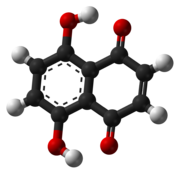
| |

| |
| Names | |
|---|---|
| Preferred IUPAC name 5,8-Dihydroxynaphthalene-1,4-dione | |
| Other names Dihydroxynaphthoquinone | |
| Identifiers | |
| CAS Number | |
| 3D model (JSmol) | |
| ChEBI | |
| ChEMBL | |
| ChemSpider | |
| ECHA InfoCard | 100.006.816 |
| EC Number |
|
| KEGG | |
| PubChem CID | |
| UNII | |
| CompTox Dashboard (EPA) | |
InChI
| |
SMILES
| |
| Properties | |
| Chemical formula | C10H6O4 |
| Molar mass | 190.154 g·mol |
| Melting point | 228–232 °C (442–450 °F; 501–505 K) |
| Hazards | |
| GHS labelling: | |
| Pictograms | 
|
| Signal word | Warning |
| Hazard statements | H302, H312, H315, H319, H332, H335 |
| Precautionary statements | P261, P264, P270, P271, P280, P301+P312, P302+P352, P304+P312, P304+P340, P305+P351+P338, P312, P321, P322, P330, P332+P313, P337+P313, P362, P363, P403+P233, P405, P501 |
| Except where otherwise noted, data are given for materials in their standard state (at 25 °C , 100 kPa).
| |
Naphthazarin, often called 5,8-dihydroxy-1,4-naphthoquinone or 5,8-dihydroxy-1,4-naphthalenedione (IUPAC), is a naturally occurring organic compound with formula C
10H
6O
4, formally derived from 1,4-naphthoquinone through replacement of two hydrogen atoms by hydroxyl (OH) groups. It is thus one of many dihydroxynaphthoquinone structural isomers.
Naphthazarin is soluble in 1,4-dioxane from which it crystallizes as deep red needles that melt at 228−232 °C.
Synthesis
Naphtharazin can be prepared by condensation of 1,4-dimethoxybenzene with 2,3-dichloromaleic anhydride followed by reductive dechlorination and reoxidation.
Naphtharazin can also be obtained by oxidation of 5,8-dihydroxy-1-tetralone with manganese dioxide (MnO2).
References
- Thomson R.H. Naturally Occurring Quinones. Academic Press, London (1971). Quoted by Khalafy and Bruce.
- Thomson R.H. Naturally Occurring Quinones III. Chapman and Hall, London (1987). Quoted by Khalafy and Bruce.
- ^ J. Khalafy and J.M. Bruce (2002), Oxidative dehydrogenation of 1-tetralones: Synthesis of juglone, naphthazarin, and α-hydroxyanthraquinones. Journal of Sciences, Islamic Republic of Iran, volume 13 issue 2, pages 131-139.
- Lewis J.R. and Paul J.J.(1977). Z. Naturforsch., B, 32: 1473. Quoted by Khalafy and Bruce.
- Huot R. and Brassard P. (1974). Can. J. Chem., 52: 838. Quoted by Khalafy and Bruce.